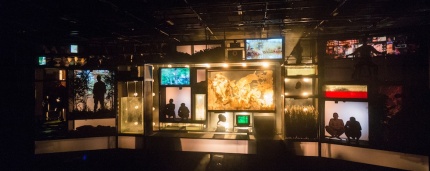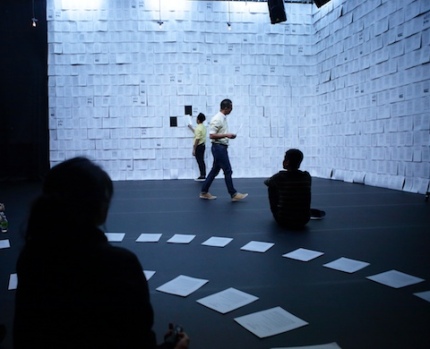Perhaps one of the most suggestive lines to have come out of the productions at this year’s Festival Theaterformen is the closing aphorism, projected upon the drawn curtains, from Ho Tzu Nyen’s “Ten Thousand Tigers”:
“The story of tigers precedes the history of men.”
It is a statement that presents the final turn upon a performance already constituted of many wicked twists and turns, seemingly presenting itself as a détournement on the very notion of history itself. For Ho Tzu Nyen the mythical figure of the tiger, as conjured by layers of histories across much of mainland Southeast Asia, embodies this very unsettling force. Yet, it distinguishes itself from the tired post-historicism where time is suspended and all that’s left is a perpetual present, for its performativity is, in fact, prehistorical. How so?
As if himself consumed by this feline apparition Ho Tzu Nyen has spent a good decade researching the figure of the cat in the history of Singapore and the broader South-East Asian region. In “Ten Thousand Tigers”, we see the material the artist has gathered realized as a living cabinet of curiosities of sorts, with each article sitting within the museological display as theatrical set taking their turn to be activated across the course of the show. Three main transfigurations of the tiger stand out: the weretiger of Malayan folklore, the Japanese foot soldier as “tiger” penetrating the forests during World War II, and the postwar communist fighter carrying out its guerilla ambush like the fearsome creature from the forest.
It appears that throughout these variations a logic of “wilding” can be discerned: the “tiger” is the figure made to perform its primitivity — and by extension, its pre-historicity — in those historical junctures where existing systems of knowledge are shattered and contingency takes over history as the structuring condition of experience. This is not the primitivism we are familiar with, where the other is shelved into an exoticized pastness; rather, the savage roar of the tiger bursts through the cabinets to demand a principle of understanding that is something completely different. The tiger, even when it rears its head, will always still remain to be seen. The story of tigers can thus only be the unwriting of history itself — an unwriting that appears to have already written itself into the official histories, where the spectres of tigers, as Ho Tzu Nyen shows us, haunt the pages.
In an exemplary instance of inspired curation, “Baling” by Five Arts Centre (Kuala Lumpur) takes off exactly at the moment when “Ten Thousand Tigers” closes. Specifically, it begins with the moment when Chin Peng, the much-feared leader of the Malayan Communist Party, emerged from the jungle to participate in the historic Baling talks of 1955, convened in an attempt to broker peace between the opposing forces of what was really a full-blown civil war (disgracefully downplayed by the British as the “Malayan Emergency”). One would think that this accordingly marks the emergence of the so-called communist “tiger” into full visibility, recuperated as the rightful subject of an alternative history. After all, “Baling” is presented very much like a history class, with the installation, replete with archival and bibliographic material, sometimes even belaboring this pedagogical aspect a little too much.
Yet, it is again the moment of putative closure that fully dismantles this structure of historical construction. The cycles of reenactment and exegesis end with a video shot by one of the actors, in real life a filmmaker lucky even to secure an interview with the exiled Chin Peng in the last years of his life. Too bad then that the trip turned out to be an utter disappointment. The man who was formerly the most wanted man across the British Empire had been reduced to a series of interminable pauses and inarticulate utterances. Remarkably, the only time that the elderly man could muster a coherent response was when he wistfully conveyed his desire to return to Malaya, the land where he was born and raised — a desire that unfortunately was never fulfilled.
As the video plays, the filmmaker relates that in his quest to seek out the elusive Chin Peng, he found instead the even more enigmatic Ong Boon Hua — the man that Chin Peng was before he joined the resistance and assumed the moniker with which he now enters history. Once again, history reverts to prehistory. What resounded in the earlier performance as an irrepressible roar now returns as a long, drawn-out pause. History, it seems, awaits itself.



